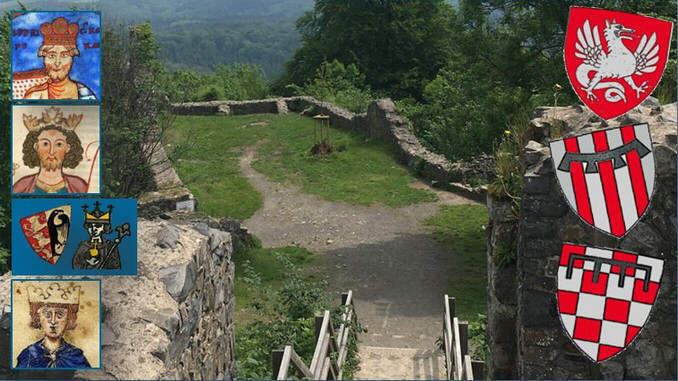
The castle ruins Drachenfels, Löwenburg, Rosenau and Heisterbach Abbey remind us of Hohenstaufen era in the Siebengebirge. We will meet famous men.
Frederick Barbarossa, Henry VI, Richard the Lionheart of England and his nephew Otto IV, and Frederick II.
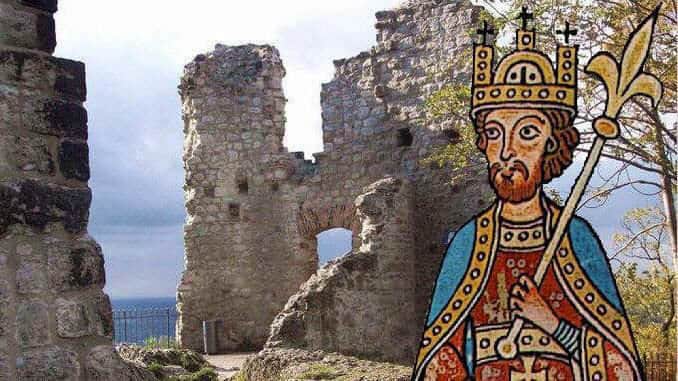
The time of Frederick I
Barbarossa
Frederick I Barbarossa (1152-1190) was the epitome of the medieval emperor. Yet, he of all people had to learn that, after the Investiture Controversy, the Pope would no longer submit to the Emperor. For many years, Frederick fought against the North Italian cities and the Pope, or both at the same time. For him, it was his regal duty to defend the rights and the honor of the Empire because Northern Italy had been part of the Empire since the time of Otto I. From the cities’ point of view, however, it was a flagrant injustice.
Eventually, Barbarossa had to negotiate peace with the Italian cities. Around the year 1254, at the height of the controversy with the Pope, the name of “Holy Roman Empire” appeared in the Hohenstaufen chancelleries.
Mighty archbishops
Here we have a special political configuration of the Holy Roman Empire: the archbishops of Cologne, Mainz and Trier were not only high ecclesiastical dignitaries, but also important political actors in the Empire.
Rainald von Dassel, Barbarossa’s Chancellor
Barbarossa’s chancellor was Rainald von Dassel, Archbishop of Cologne. Rainald very much influenced Barbarossa’s rigid policy. Diplomatic missions took him abroad, also to the court of Henry II Plantagenet to win him over to Barbarossa’s side against the Pope.
Sword and bishop’s staff
And yes, the medieval archbishop of Cologne in the Hohenstaufen era had to keep his sword and bishop’s staff ready. They reigned over large territories, obtained the right to levy tolls along the Rhine and to build fortifications. Since the days of Archbishop Hermann II (1036 – 1056), they had the right to crown the kings in Aachen. From the 13th century onward, they were among the prince-electors who had the privilege of electing the monarchs, so we call them prince-archbishops.
The relics of the Magi come to Cologne
After conquering and destroying Milan, Barbarossa took the relics of the Three Kings, and gave them to his chancellor Rainald von Dassel. In 1164, Rainald brought them to Cologne. From then onward, the Three Kings have brought many pilgrims to Cologne.
Third crusade
Finally, peace reigned in the empire, Barbarossa was respected on all sides. His eldest son and heir to the throne, Henry VI, already joined the government. In 1186, he had married Constance d’Hauteville, heiress to the Norman Kingdom of Sicily.
Yet alarming news from the Middle East arrived. In July 1187, the Arabs under Sultan Saladin had crushed a Christian army, In October, they had taken Jerusalem. In 1189, the old emperor took the cross and set out for Palestine. But to see Jerusalem was not granted to him, he died in Anatolia before reaching the Holy Land.
Back then in the Siebengebirge
The archbishops of Cologne had their say in our region as well. Since 1118, their castle stood on Mount Wolkenburg; it was the first castle in the Siebengebirge. But their supremacy in the region was more and more disputed by the Counts of Sayn from the south and the Counts of Berg from the north.
The Counts of Berg
The Counts of Berg were a powerful family. Already twice family members had served as archbishops of Cologne, and they continued to strive for this position. In those years we meet them only in the northern part of the Siebengebirge region. They were bailiffs of the Benedictine Abbey above the city of Siegburg, and thus also its provostry in Oberpleis (today Königswinter-Oberpleis).
The Counts of Sayn
The Counts of Sayn had their homeland in the Westerwald region in today’s Rhineland-Palatinate. When they set out to obtain power and possession in the Bonn area, they got in the Archbishopric’s way. Both sides took up arms.
Drachenfels Castle
To fortify his position, in 1140 the Archbishop Arnold I of Merxheim (1137-1151) gave order to build a castle on the Drachenfels. But his men plundered in the surrounding villages, destroying fields and vineyards. Many of them belonged to the St. Cassius-Stift in Bonn. Consequently, abbot Gerhard of Are wanted to purchase the castle.
But only when the archbishop himself got in trouble, he gave in. In 1149, the St. Cassius-Stift became the new owner of Castle Drachenfels.
In 1167, by the time of archbishop Rainald von Dassel, Drachenfels Castle was finished. It was a hilltop castle, well protected by its location and bretèches with machicolations. Attackers could hardly bring up heavy siege equipment; they were also exposed to fire arrows and stones.
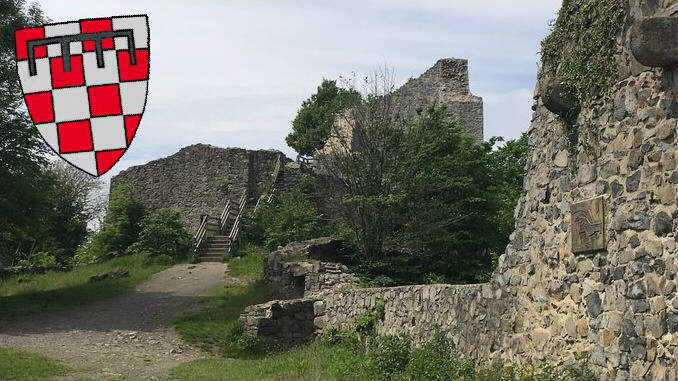 Medieval castles
Medieval castles
Read more about the medieval castles in the chapter on castle ruins
Drachenfels Castle
Löwenburg Castle
Rosenau Castle
Cistercian monks arrive in the Siebengebirge
After the Emperor, Archbishop of Cologne Philipp von Heinsberg (1167-1191) was the mightiest men in the Empire. He even fought the Emperor, and for some time Barbarossa laid an embargo on Cologne and blocked traffic on the Rhine. In 1189, the archbishop called for Cistercian monks to settle in the Siebengebirge. The monks built a hermitage in honor of Mary on a mountain called the Stromberg.
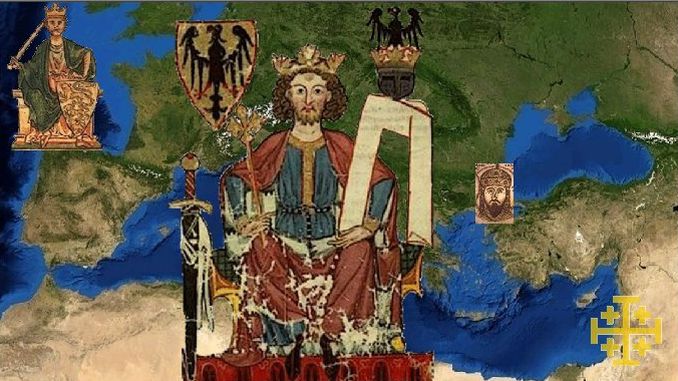
Henry VI
Back then, Henry VI (1190-1197), son and successor of Frederick I. Barbarossa, was on the throne. During his short reign, he became more powerful during his short reign than all his predecessors.
Henry VI and Richard I
Henry VI was the Emperor who held king Richard I Lionheart of England prisoner for more than a year. The Robin Hood movies take place in those years. Finally, in 1194, Richard’s mother Eleanor of Aquitaine brought the incredibly high ransom money and Richard was released. Nonetheless, he had to send hostages, among them was his nephew Otto, son of Richard’s sister Matilda Plantagenet und Duke Henry the Lion of Saxony.
The short world empire
Meanwhile, King William had died childless in Palermo, making Henry’s wife Constance the rightful heir to the Kingdom of Sicily. However, the Norman barons had created other facts and raised one of their own to the throne. The Pope backed them because he wanted to prevent a Staufer rule north and south of the Papal States at all costs. Henry and Constance had to conquer southern Italy and Sicily. A first campaign in 1191, right after Henry’s imperial coronation, had failed.
Now, with the gigantic ransom in the war chest, Henry conquered Sicily. The Pope’s nightmare had come true. On December 25, 1194, he was crowned in Palermo; one day later, his son Frederick was born. Henry was the mightiest ruler of the Hohenstaufen era. His empire was a world power, but the emperor was loathed.
Henry VI died very early in Italy. His sudden death left the Empire in chaos, even anarchy. His son Frederick was only two years old, and his widow Constance broke with the Hohenstaufen and the Empire.
Back then in the Siebengebirge
in 1193, The Cistercians left Mount Petersberg to live in the nearby valley of Heisterbach. Here, they built their great abbey churches. In the Middle Ages, it was the largest in our region, only the Gothic Cathedral of Cologne was bigger and higher.
The time of Otto IV
Emperor Henry VI died very early in Southern Italy, probably from malaria. His sudden death left the Empire in chaos, even anarchy. His young son Frederick was only two years old, his widow Constance broke with the Hohenstaufen and the Empire.
The war for throne (1198-1208)
Soon, a civil war broke out in Germany between Otto IV of the Welf-Plantagenet family and Philip of Swabia from the Hohenstaufen family. Pope Innocent III and King Richard I of England support Otto, the French King Philip II. Since Cologne was Otto’s capital, the Rhineland was devastated. In 1208, it seemed that Philip had won, but then he was assassinated.
The Angevin on the imperial throne
During the following years, Otto reigned as king and from 1209 on as emperor. While the Hohenstaufen emperors represented the medieval empire’s glory, Otto had an undeserved bad press for a long time and is often considered as a misfit in the Hohenstaufen era. Yet, he was a bright man and a brave, capable warrior, after all Richard the Lionheart had taught him. Unlike his father or the Hohenstaufen emperors, he did not give orders to destroy entire cities to punish them for rebellion.
Back then in the Siebengebirge
Caesarius of Heisterbach
Thanks to Caesarius, we know a lot about this time. In his most famous work, the “Dialogus miraculorum” (1219/23), he described the everyday life at the abbey in miracle stories. As Caesarius was a novice master, he wrote for teaching, so there almost always is a dialogue between a monk and a novice.
Moreover, Caesarius was an important chronicler of the political events. He reported on the war for the throne between Otto and Philip. Later, in 1225, about the violent death of archbishop Engelbert of Cologne, and another then years later he wrote the life story of Saint Elizabeth of Hungary.
The castle on the Löwenburg
The counts of Sayn stood firmly on Otto’s side. An embittered feud raged between them and Dietrich of Landsberg, a supporter of the Hohenstaufen. Count Heinrich II von Sayn (1172-1202) had Löwenburg Castle built towards the end of the 12th century. Back then, it was just a simple tower house. Only the marriage between Count Heinrich III of Sayn and Mechthild of Landsberg ended the feud.
Italian campaign and Bouvines
But when Otto resumed the Hohenstaufens’ policy and went for Southern Italy and Sicily, the Pope broke with him and now supported Frederick of Hohenstaufen who lived since his childhood in Sicily. Again, a civil war broke out (1212-1215). For some years, neither Otto nor Frederick won.
Finally, Otto supported his uncle John Lackland of England against the king of France, and suffered a crucial defeat in the battle of Bouvines in 1214. Soon, the way for Frederick was open.
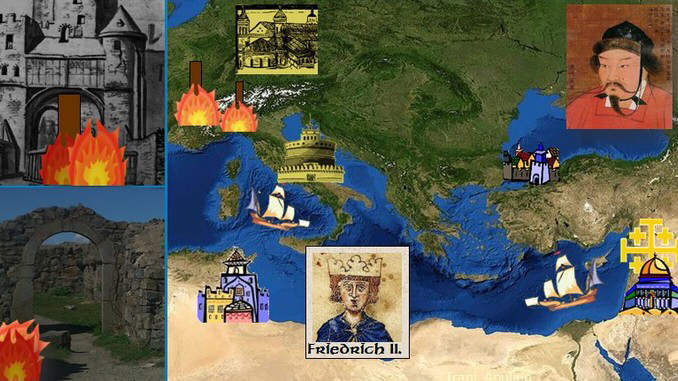
The time of Frederick II
In 1215, he was crowned King in Aachen, in 1220 Emperor in Rome.
The Sicilian on the throne
Already in his time they called him Frederick II “stupor mundi” (astonishment of the world) because of his extraordinary knowledge of languages, philosophy, astronomy, mathematical, natural sciences and also of foreign cultures, especially the Arab culture. He spent most of his life in Southern Italy, which was his home. Here he drew up his legislative work and wrote his famous falcon book “De arte venandi cum avibus”, and here he constructed his castle Castel del Monte.
In Germany, he yielded greater powers to the dukes, so they became mighty sovereign in their countries. On the other hand, the Kings’ power declined more and more, giving way to a period of political instability (Interregnum) and soon a monarchy in which the real power was with the dukes.
This so curious and open-minded Emperor drew up very rigid laws against heresy. In his eyes, heresy it was not only a crime against the Church, but a crime against the Crown. Soon, stakes were burning all over Germany.
Back then in the Siebengebirge
Accusation
In 1233, Count Heinrich III von Sayn, Lord of Löwenburg, was accused of heresy. The inquisitor, prosecutor, and judge at the same time, found him guilty. However, the powerful count managed to take his case out of the inquisitor’s extraordinary jurisdiction and bring it before a secular court. This acquitted him.
Rosenau Castle
Back then, a little castle stood on top of Mount Rosenau below Mount Ölberg. However, we know very little about it. Obviously, it was built in great haste within a few years. Since 1222, a certain Dietrich of Dorndorf, a lower aristocrat, called himself Dietrich Count of Rosenau. He died in 1243, and still in the same year his family sold the castle Rosenau to the nearby Heisterbach Abbey. The monks had it destroyed around 1250. The motives for that have remained in the dark until today.
End of the Hohenstaufen dynasty
During the reign of Frederick II., the conflict between the Emperor and the Pope culminated in a tragic way. The so-called “final fight” was a war of extermination.
Frederick II died in December 1250 in Castel Fiorentino. The Pope’s hatred followed him beyond his death. His sons Manfred and Konrad and his grandson Conradin died in battle, fighting for their inheritance. But France, the Popes’ ally in the fight against the Staufer, was soon to turn against them.
Middle Ages, Hohenstaufen era | Read more
Wikipedia, Richard the Lionheart | Wikipedia, Otto IV
Intro Middle Ages | Ottonian and Salian Dynasties | Hohenstaufen Dynasty | Late Middle Ages

Be the first to comment